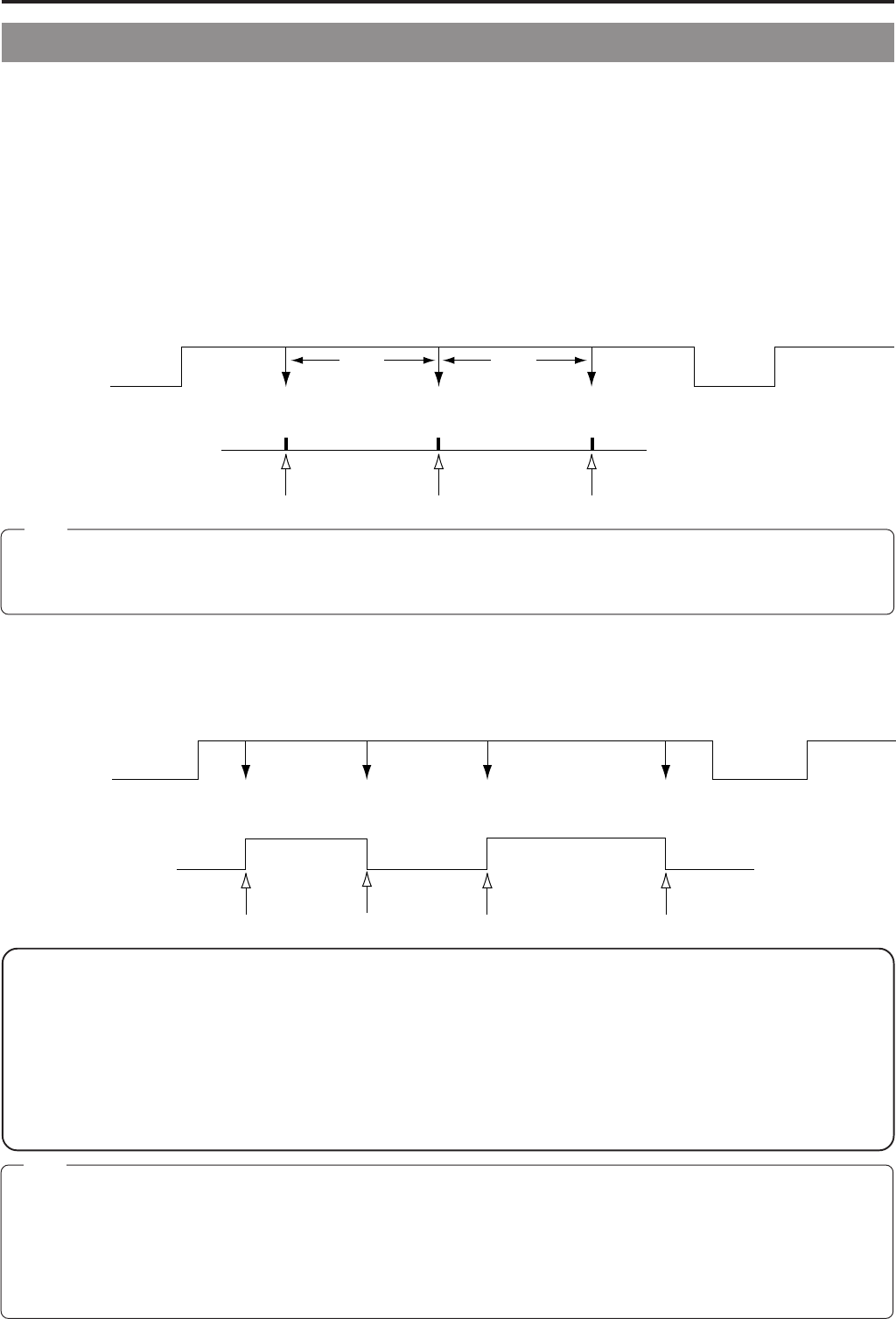
10. S.S.F. (Super Scene Finder) FUNCTION
66
Shooting started
with VTR trigger
REC start REC pause
Cut
IN
time code data
OUT
time code data
OUT
time code data
IN time
code data
TAKE button TAKE button TAKE button TAKE button
Scene 1 Scene 2
10-1 Explanation of the S.S.F. Function
During recording, the S.S.F. function records the time code data at the point of time of a desired recorded scene in the unit's
memory. Using the S.S.F. data stored in memory during after-processing of the recorded image allows efficient use of the tape.
The S.S.F. function comprises the two modes CUE and MARK. Select the mode using the VCR Setup Menu item No. 398 S.S.F.
MODE.
When the VCR Setup Menu item No. 398 SSF MODE is set to CUE MODE or MARK MODE, the time code generator’s running
method is internally set to the REGEN mode.
When shooting in either of the modes, the time code data is stored in the unit's memory when the TAKE button on the front section
is pressed.
The model ID data, reel number, the number of each scene, and the time code data of IN points, OUT points, and CUE points are
recorded as S.S.F. data.
Ⅲ CUE Mode:
When the TAKE button is pressed at the desired scene during shooting of a given cut, the time code data at that point is stored
as CUE data in the unit's memory. The time code data at the time when recording is started or stopped with the VTR TRIGGER
button are stored in the unit’s memory as scene data.
Ⅲ MARK MODE
During shooting of a given cut, press the TAKE button at beginning of a desired scene and then press the TAKE button again at
the ending of the scene.
The time code data at the point where the TAKE button is pressed first becomes the start point of the scene and time code data
at the point where the TAKE button is pressed the second time becomes the ending point, and both are stored in the unit's
memory.
Shooting started
with VTR trigger
REC start REC pause
Scene
CUE 1
time code data
5 sec
or more
5 sec
or more
CUE 2
time code data
CUE 3
time code data
TAKE button TAKE button TAKE button
IN
time code data
OUT
time code data
• When recording is not performed in the S.S.F. mode, be sure to set the VCR SETUP MENU item No. 398 SSF MODE to OFF.
• Be sure to record S.S.F. data continuously on the same tape. It is not possible to rewind the tape for overwriting during the
recording.
If the tape is rewound in the middle of a recording, or after similar operation is performed, be sure to use the Scene End Cue
Up function in order to ensure that new data are recorded in continuation of the existing data.
☞ See “About the Scene End Cue Up Function” on page 69.
* In the S.S.F. mode, the STBY/SAVE switch does not activate the VTR save mode. (The save mode is activated by a long
pause.)
Note:
• Leave an interval of at least 5 seconds between memorization of CUE data.
If the TAKE button is pressed within 5 seconds from the previous point, the new point is not memorized.
• In the CUE mode, time code log data stored on the camera memory may differ from the actual time code recorded on tape
at the time of pressing the TAKE button. This difference may be within 3 frames and it is not a malfunction.
Note:
• The number of scenes that can be registered is 127, and up to 238 registered scene numbers can be stored in memory.
When either of these capacities is reached, the indication showing the number of registered scenes on the viewfinder screen
becomes “M: - - -”.
• Up to 253 CUE points can be stored in memory.
For each registered CUE point, the scene number decreases by two.
• When recording in the S.S.F. mode, the reel number (cassette number) for each cassette is recorded in the memory of the
GY-DV550 and on tape.
• When the videocassette is replaced, new S.S.F. data is generated. S.S.F. data for six videocassettes can be stored in the
internal memory.
Before recording the seventh cassette in the S.S.F. mode, be sure that necessary data has been transferred from the
memory to the non-linear editing controller or other component, or write data to the tape for each recording. ☞ See page 69.


















